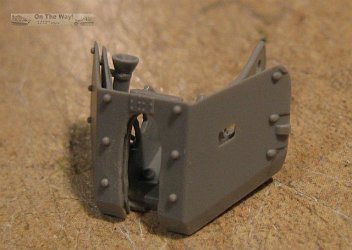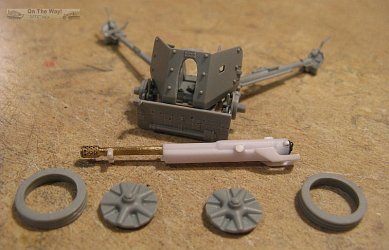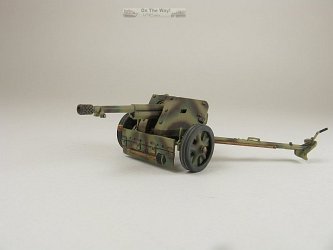|
7.5cm Pak 97/40 kitbash using the Dragon & Ace kits
I first came across this gun in a couple of my older reference books ([1] & [2] below). Subsequent searching through other
books and on the web failed to find any period photos of it. This I find rather odd since the Germans seemed to photograph pretty much everything they built, whether
it be a
production weapon, a trials weapon or even a wood mock-up. It's even more odd that reference [3] and [10] both state that approximately 160 7.5cm Pak 97/40 guns were
manufactured, yet, other rare German
anti-tank guns with similar production runs have war time photographic evidence (e.g. FK 7M85, 8cm PWK 8H63 ) while nothing survives picture wise for this gun. One
would be in doubt of its very existence were it not for numerous surviving ammo boxes bearing stenciling for this gun on their lids (see references [4] through [9]).
Undeterred by the lack of photographic evidence, I decided to build an example of this gun, and with no photos to guide me I had pretty much a free hand to go with whatever I felt was appropriate. I knew that this
gun was another stop gap like the 7.5cm Pak 97/38, a gun that was the combination of the barrel from the French Canon de 75 modèle 1897 fitted with a
Solothurn style muzzle brake and mounted on the carriage of the German 5cm Pak 38. So it didn't seem to be much of a stretch that the 7.5cm Pak 97/40 would use
the same set up of barrel and muzzle brake as that of it's smaller brother, only to be mounted on the carriage of the German 7.5cm Pak 40 instead of a 5cm Pak 38 carriage.
With those thoughts in mind my conversion started with the Dragon Pak 40 kit with some part donations from the Ace Pak 97/38 kit. I also decided that an RB Model
barrel (no. 72B50) for the Pak 97/38 would be the best option for the build.
Conversion started with the gun and slide. These were liberated from the Ace kit and the RB Model barrel replaced the Ace part. The Dragon kit provided the carriage
and shield. The sole major modification was for the slot in the shield for the barrel, which was widened slightly at the top to allow the wider barrel of the French
gun to fit, just as was done for the Pak 97/38. According to my references the conversion was performed on early Pak 40 carriages so I chose the early style disk
pattern wheels.
So, using parts from two kits and a small adjustment to the shield for the new barrel gives you have a simple conversion. Is it a "fictional" gun? Maybe, but I
believe with the ammo boxes as proof, the "fiction" aspect is pretty much negated. Only the final look is up for debate.





References
[1] German Anti-Tank Guns 1939-1945, T.J.Gander, Almark Publications, New Malden, England 1973 ISBN: 0 85524 142 X
[2] WW2 Fact Files: Anti-Tank Weapons, Peter Chamberlain & Tony Gander, MacDonald & Janes, 1974 ISBN: 0 35608 065 X
[3] Antitank Artillery of the Wehrmacht 1939-45, Maxim Kolomiets, MK Strategy, Moscow, Russia 2006 ISBN: 5-901266-01-3
[4] wehrmachts.kisten.free.fr (ammo box photo)
[5] relicsww2.com (ammo box photo)
[6] wehrmachts.kisten.free.fr (ammo box photo)
[7] axishistory.com (ammo box photo)
[8] naturabuy.fr (ammo box photo)
[9] osta-ee.postimees.ee (ammo box photo)
[10] wikipedia
|




